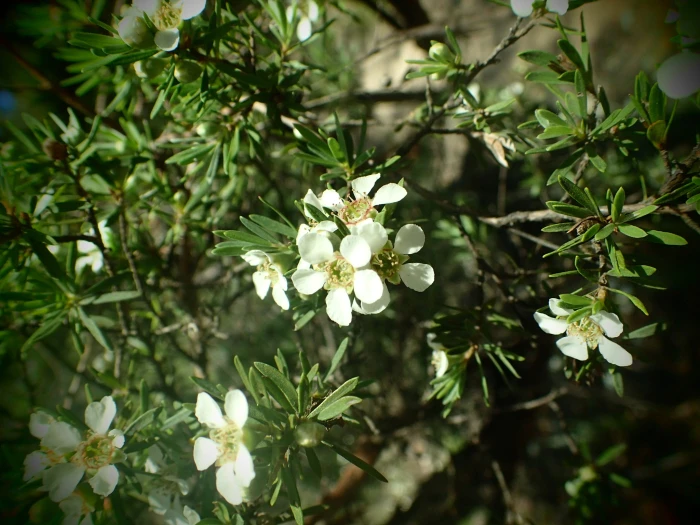Jellybush
(Leptospermum polygalifolium)
Jellybush (Leptospermum polygalifolium)
/
/

ronavery
CC BY 4.0
Image By:
ronavery
Recorded By:
Copyright:
CC BY 4.0
Copyright Notice:
Photo by: ronavery | License Type: CC BY 4.0 | License URL: http://creativecommons.org/licenses/by/4.0/ | Rights Holder: ronavery | Publisher: iNaturalist | Date Created: 2017-12-29T10:33:37-08:00 |






















Estimated Native Range
Climate Requirements for Gelsenkirchen, Germany
| This Plant | Your Site | Plant Suitability for Your Location | ||
|---|---|---|---|---|
| • Precipitation | 7" - 166" | 35" | Aquatic | Aquatic |
| • High Temp. | 63°F - 101°F | 75°F | Your summer temperatures are normal for this plant. | Excellent |
| • Low Temp. | 3°F - 73°F | 32°F | Your winter temperatures are normal for this plant | Excellent |
This plant should grow well at your location with about N inches per year (Y minutes per month) of irrigation.
Summary
Leptospermum polygalifolium, commonly known as Jellybush, is an evergreen shrub or small tree native to coastal heathlands, open forests, and swamp margins in Eastern Australia and Norfolk Island. It typically grows to a height of 0.5–3 meters (1 ft 8 in – 9 ft 10 in) when shrubby, but can reach over 7 meters (23 ft) as a tree. Jellybush has thin, fibrous bark and elliptical leaves that are aromatic when crushed. Its white, greenish, or cream-colored flowers, sometimes pink, are about 10–15 mm (0.39–0.59 in) in diameter, appearing mainly from August to January, and are quite showy as they are profuse and attract a variety of pollinators. The fruit, a woody capsule, persists on the plant for several years.
Jellybush is valued for its ornamental flowers, honey production, and as a source of ’Manuka’ honey, which has medicinal properties. It is used in gardens for screening and as a feature plant due to its attractive form and flowers. This species is adaptable to a range of soil types, provided they are well-drained, and it thrives in full sun. While it tolerates medium amounts of water, it is also quite drought-resistant once established. Jellybush is relatively low-maintenance but can be affected by webbing caterpillars and scale insects. It is not known for aggressive roots or significant disease problems.CC BY-SA 4.0
Jellybush is valued for its ornamental flowers, honey production, and as a source of ’Manuka’ honey, which has medicinal properties. It is used in gardens for screening and as a feature plant due to its attractive form and flowers. This species is adaptable to a range of soil types, provided they are well-drained, and it thrives in full sun. While it tolerates medium amounts of water, it is also quite drought-resistant once established. Jellybush is relatively low-maintenance but can be affected by webbing caterpillars and scale insects. It is not known for aggressive roots or significant disease problems.CC BY-SA 4.0
Plant Description
- Plant Type: Shrub
- Height: 2-9 feet
- Width: 10-15 feet
- Growth Rate: Moderate
- Flower Color: White
- Flowering Season: Spring, Summer
- Leaf Retention: Evergreen
Growth Requirements
- Sun: Full Sun
- Water: Medium
- Drainage: Fast
Common Uses
Bee Garden, Bird Garden, Border Plant, Butterfly Garden, Deer Resistant, Drought Tolerant, Groundcover, Hedges, Low Maintenance, Showy Flowers, Street Planting
Natural Habitat
Coastal heathlands, open forests, and swamp margins in Eastern Australia and Norfolk Island
Other Names
Common Names: Tantoon, Yellow Tea Tree
Scientific Names: Leptospermum polygalifolium, Leptospermum flavescens var. javanica
GBIF Accepted Name: Leptospermum polygalifolium Salisb.